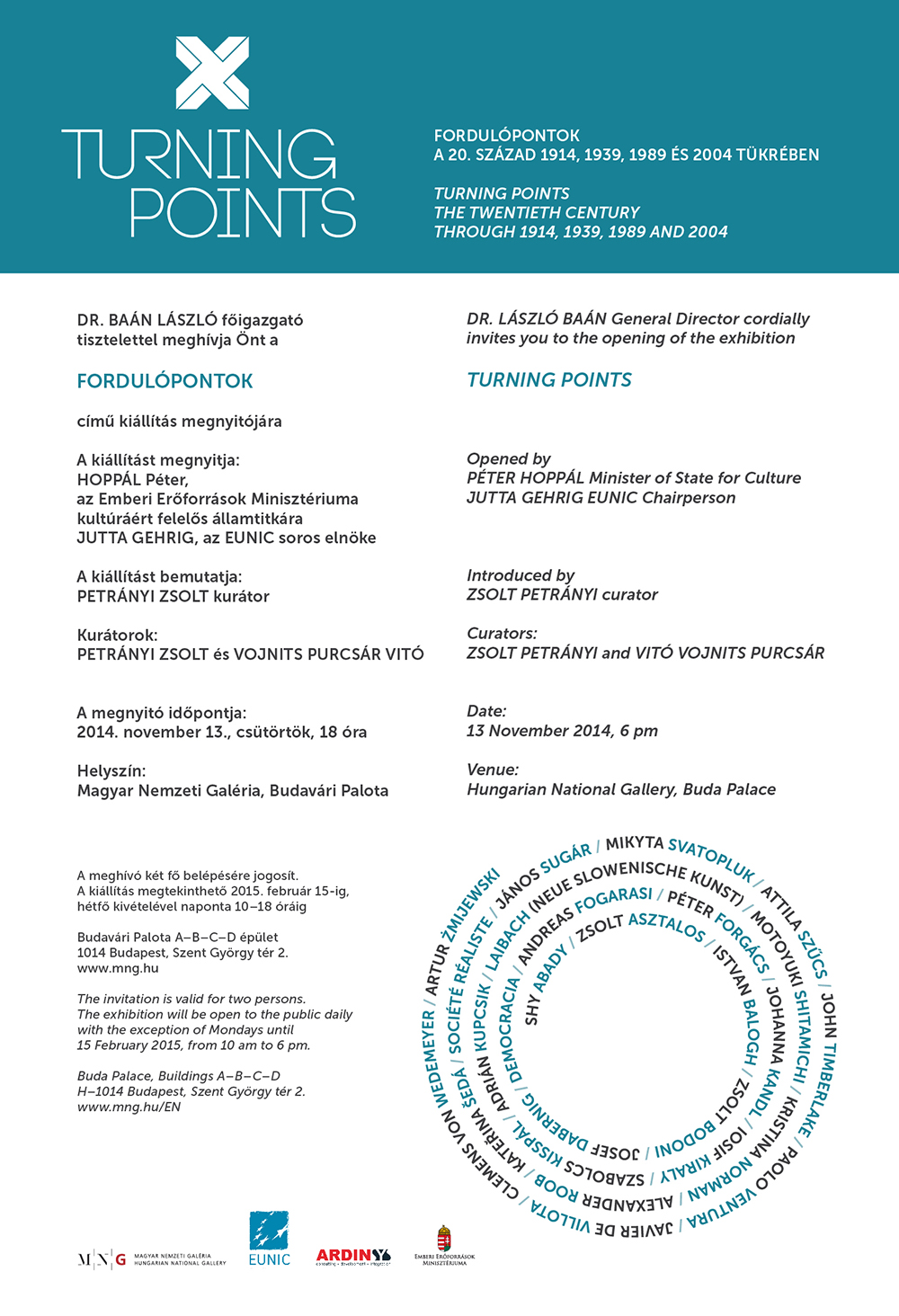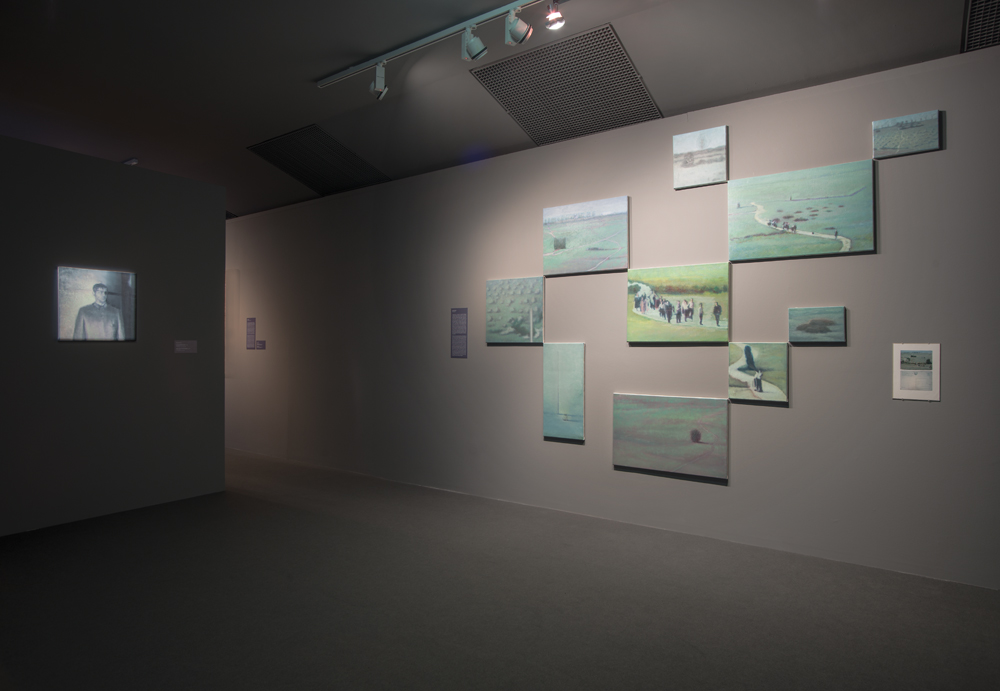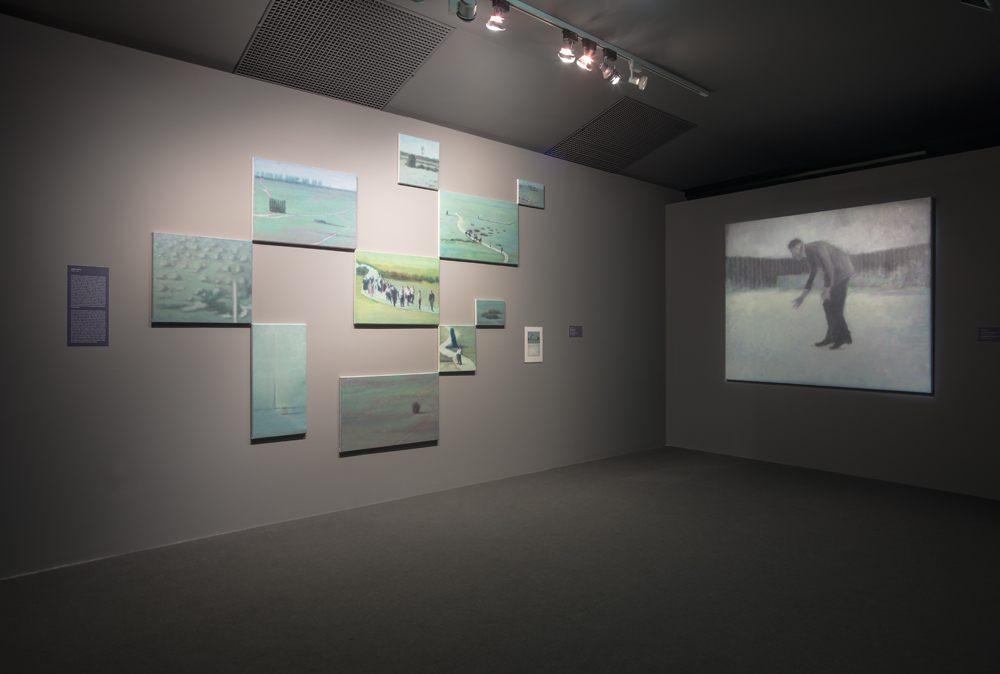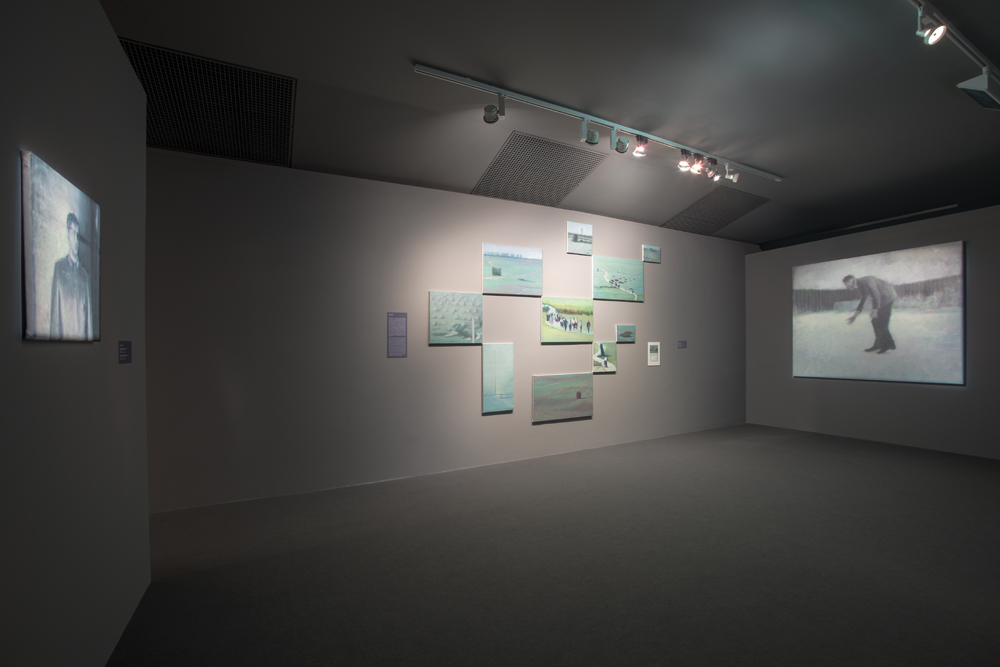TURNING POINTS
The twentieth century through 1914, 1939, 1989 and 2004.
Contemporary art exhibition 14 November 2014 – 15 February 2015 Hungarian National Gallery, Building C, 3rd floor
Please, click the image below to start the virtual tour.
photos: Tibor Mester

//for English please scroll down//
Fordulópontok / Turning Points
A huszadik század 1914, 1939, 1989 és 2004 tükrében.
Kortárs művészeti kiállítás 2014. november 14. – 2015. február 15. Magyar Nemzeti Galéria, C épület, III. emelet
A kiállítás az EUNIC, a European Union National Institutes for Culture és a Szépművészeti Múzeum – Magyar Nemzeti Galéria közös együttműködésében jön létre.
A Fordulópontok a Magyarországon működő külföldi kulturális intézetekkel együtt létrehozott jelenkori képzőművészeti projekt. Tizenhat ország huszonhat alkotója Angliától Izraelig, Spanyolországtól Japánig elemzi a történelmet és a múlt évszázadot: bennünk, a nézőkben új, személyes, érzelemteli gondolatok ébrednek a múltról, amelyet átéltünk vagy az előző nemzedékek elbeszéléséből ismerünk.
A Fordulópontok kiállítás csak részben illik a jubileumi rendezvényeinek sorába. Bár a történelmi eseményekről való megemlékezések együttállása, az első és a második világháború kitörése, a berlini fal leomlása vagy az Európai Unió keleti bővülésének 10. évfordulója tény, a rendezőket inkább az foglalkoztatja – és az erről való gondolkodásra szeretnék ösztönözni a kiállítás nézőit is –, hogy mi adja a 20. század ívét, a 21. század elejéről visszatekintve, mi a történelmi események mögött és fölött az összekötő motiváció, jellegzetesség vagy karakter.
Alain Badiou francia filozófus – más gondolkodókkal együtt – a 20. századot a legrövidebb századnak tartja abban az értelemben, hogy a fontos eseményei 1914-ben kezdődtek és 1989-ben értek véget. Európa konfliktusai, nemzeti kérdései, a nagyhatalmak versengése és gyarmatosítási igényeik vezettek az első világháborúhoz, a „nagy háborúhoz”, illetve „a második harmincéves háború”-nak is nevezett (1618–1648: az első harmincéves háború) korszakhoz. A második világháború az elemzők szerint az első háború kiterjesztett folytatásaként értelmezhető, amelyben a vitás kérdések töretlenül jelen voltak és elmélyültek. A konfliktusok század elején meginduló folyamát a hidegháború évei után végül a szocialista rendszerek felbomlása és az Európai Unió erősödő integrációs folyamatai zárják le.
Az eseményekre reflektáló művészet minden esetben tágabban, nagyobb általánosságban fogalmaz, mint amit az adott jubileum jelent. Az alkotók az évfordulót inspirációnak tekintik, olyan gondolatébresztő eseménynek, amely során újabb összefüggéseket, gondolatokat érthetünk meg. A Fordulópontok kérdéseket fűz a jubileumok köré: ilyen a háború meghatározó volta, mai aktualitásának veszélye, szinte folyamatossága az elmúlt száz évben, a totalitárius rendszerek retorikája és szimbólumrendszere, emberképe, a két nagy gazdasági-politikai világrend, a kapitalizmus és a szocializmus szemben állása és szerepe a történelem alakulásában, valamint az új gazdasági rend sokkja a felbomló Szovjetunió utódállamaiban, illetve Kelet-Európa volt szocialista államaiban. Az egyes művek érintik az emlékezet kérdését is: mindezeket az eseményeket hogyan dolgozza fel az utókor, hogyan viszonyulunk saját személyes és történelmi múltunkhoz egy olyan időszakban, amikor lassan nyilvánvalóvá válik, hogy az új évezred nem tudta/tudja az emberiséget átléptetni az előző század örökségén.
Kurátorok: Petrányi Zsolt és Vojnits Purcsár Vitó
Kiállító művészek: Johanna Kandl, Andreas Fogarasi, Joseph Dabernig (Ausztria), Clemens von Wedemeyer, Alexander Roob (Németország), Shitamichi Motoyuki (Japán), Shy Abady (Izrael), John Timberlake (Anglia), Societé Realiste (Franciaország), Iosif Kiraly (Románia), Mikyta Svatopluk (Slovákia), Artur Żmijewski (Lengyelország), Democracia, Javier de Villota (Spanyolország), Kateřina Šedá (Csehország), Kristina Norman (Észtország), Istvan Balogh (Svájc), Paolo Ventura (Olaszország), Laibach (Neue Slowenishe Kunst) és a magyar művészek: Asztalos Zsolt, Bodoni Zsolt, Forgács Péter, Szűcs Attila, Sugár János, Kisspál Szabolcs és Kupcsik Adrián.
Turning Points
The twentieth century through 1914, 1939, 1989 and 2004.
Contemporary art exhibition 14 November 2014 – 15 February 2015 Hungarian National Gallery, Building C, 3rd floor
The exhibition was made possible through cooperation between EUNIC, the European National Institutions for Culture and the Museum of Fine Arts – Hungarian National Gallery.
Turning Points is a contemporary art project created together with foreign cultural institutes operating in Hungary. Twenty-six artists from sixteen countries from Great Britain to Israel, from Spain to Japan present their analysis of history and the last century, awakening in us new, personal and emotional ideas about the past that we lived through, or which we know from listening to older generations.
The Turning Points exhibition is only loosely connected with the multitude of anniversaries that are currently being commemorated – the starts of World Wars I and II, the fall of the Berlin Wall, and the eastward expansion of the European Union – but the organisers were more concerned with the overarching nature of the twentieth century, with the unifying motivation or character that lay behind the historical events, and this is what we would like to inspire visitors to the exhibition to reflect on.
The French philosopher Alain Badiou – among others – regards the twentieth century as the shortest century, given that significant events began in 1914 and ended in 1989. European conflicts, issues of nationality, and rivalry and colonial ambitions among the superpowers led to World War I, the “Great War”. Many analysts see World War II as the delayed continuation of the first, because many unsettled questions never went away, but only grew more entrenched. The sequence of conflicts that began at the start of the century and continued through the Cold War finally came to an end with the collapse of the socialist regimes and the strengthening of European Union integration.
The art reflecting on the events provides a broader, more general expression of meaning than any given jubilee. For artists, an anniversary is an inspiration, an occasion that prompts ideas, which can lead us to a new understanding of connections and thoughts. Turning Points weaves questions in between and around the anniversaries, such as the defining nature of war, the danger of current affairs today and their virtual continuity throughout the last hundred years, the rhetoric, symbolism and human image of totalitarian regimes, the contrast between the two main economic and political world orders, socialism and capitalism, and their role in the path taken by history, and the shock of the new economic system in the successor states of the disintegrating Soviet Union and in the former socialist nations of Eastern Europe. Some works also deal with the question of remembering: how these events are treated by posterity, how we relate them to our own personal and historical past, at a time when it is slowly becoming clear that the new millennium has not succeeded in helping humanity to transcend the heritage of the preceding century.
Curators: Zsolt Petrányi and Vitó Vojnits Purcsár
Exhibiting artists: Johanna Kandl, Andreas Fogarasi, Josef Dabernig (Austria), Kateřina Šedá (Czech Republic), John Timberlake (England), Kristina Norman (Estonia), Société Realiste (France), Clemens von Wedemeyer, Alexander Roob (Germany), Shy Abady (Israel), Paolo Ventura (Italy), Motoyuki Shitamichi (Japan), Artur Żmijewski (Poland), Iosif Kiraly (Romania), Mikyta Svatopluk (Slovakia), Laibach (Neue Slowenische Kunst), Democracia, Javier de Villota (Spain), Istvan Balogh (Switzerland), and the Hungarian artists: Zsolt Asztalos, Zsolt Bodoni, Péter Forgács, Attila Szűcs, János Sugár, Szabolcs Kisspál and Adrián Kupcsik.


